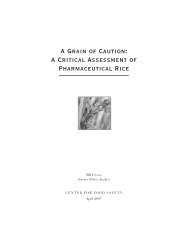a four-fold rise - Center for Food Safety
a four-fold rise - Center for Food Safety
a four-fold rise - Center for Food Safety
Create successful ePaper yourself
Turn your PDF publications into a flip-book with our unique Google optimized e-Paper software.
<strong>Center</strong> <strong>for</strong> <strong>Food</strong> <strong>Safety</strong> – Science Comments – FG72 Soybean <br />
34 <br />
In fact, glufosinate is one of 22 pesticides that has been identified by the EU as a reproductive, <br />
carcinogenic or mutagenic chemical and thus will not have its registration renewed in 2017 <br />
(EFSA 2005). <br />
APHIS says that “[g]lufosinate-‐ammonium is classified as not likely to be a human carcinogen <br />
and has no mutagenicity concern…”, but fails to mention these international concerns over <br />
reproductive toxicity (DEA at 59). <br />
Given the dramatic increases in use that will be brought about if FG72 soybean is approved, <br />
APHIS should explore these impacts in an Environmental Impact Statement. <br />
6. Herbicide-‐resistant weeds and approval of FG72 soybean <br />
Bayer CropScience’s rationale <strong>for</strong> developing FG72 soybean is to add an herbicide, isoxaflutole, <br />
with a mechanism of action not used be<strong>for</strong>e in soybeans to control weeds that have become <br />
resistant to glyphosate and other herbicides. However, this advantage of isoxaflutole only <br />
operates as long as weeds do not develop resistance to it, too. <br />
A few years after isoxaflutole was introduced, weeds resistant to triazine and ALS herbicides <br />
were then the major problem in corn: “Balance Pro also has the advantage that it controls <br />
certain herbicide-‐resistant weed biotypes such as triazine-‐resistant pigweed, lambsquarters, <br />
and velvetleaf and ALS-‐resistant waterhemp, eastern black nightshade, and ragweed. Balance <br />
Pro is an HPPD-‐inhibiting herbicide. Currently there are no reported cases of HPPD-‐resistant <br />
weed biotypes in the world, but this mode of action has not been used extensively. The lack of <br />
current cases of resistance does not preclude development of resistance problems in the <br />
future” (Wisconsin Department of Agriculture 2002). <br />
Since then, glyphosate-‐resistant weeds have become a major problem throughout the corn and <br />
soybean growing regions, and, as Wisconsin predicted, HPPD-‐resistant weed biotypes have <br />
indeed appeared in cornfields. <br />
APHIS presents an unsatisfactory assessment of weed resistance and the impact of FG72 <br />
soybean on development of resistance of weeds to isoxaflutole. First, they greatly <br />
underestimate the extent of current GR resistance in weeds in the U.S. by at least 15-‐<strong>fold</strong> (DEA <br />
at 42, citing Hubbard 2008). APHIS cites an outdated figure <strong>for</strong> glyphosate-‐resistant infested <br />
acreage of “approximately two million acres of farmland in the U.S.” (DEA at 42). As discussed <br />
below, the true figure is at least 30-‐40 million acres. <br />
Then APHIS misinterprets the significance of the development of HPPD-‐resistant weeds in <br />
corn – corn rotations <strong>for</strong> the likelihood of similar pressure <strong>for</strong> resistance in FG72 soybean – <br />
corn rotations (DEA at 43): <br />
Since 2009, <strong>four</strong> populations of common waterhemp in Illinois, Iowa, and Nebraska <br />
corn fields were reported to be resistant to 4-‐HPPD inhibitors (Heap, 2011b). While <br />
three of these biotypes were resistant to the triketone family of 4-‐HPPD inhibitors,







